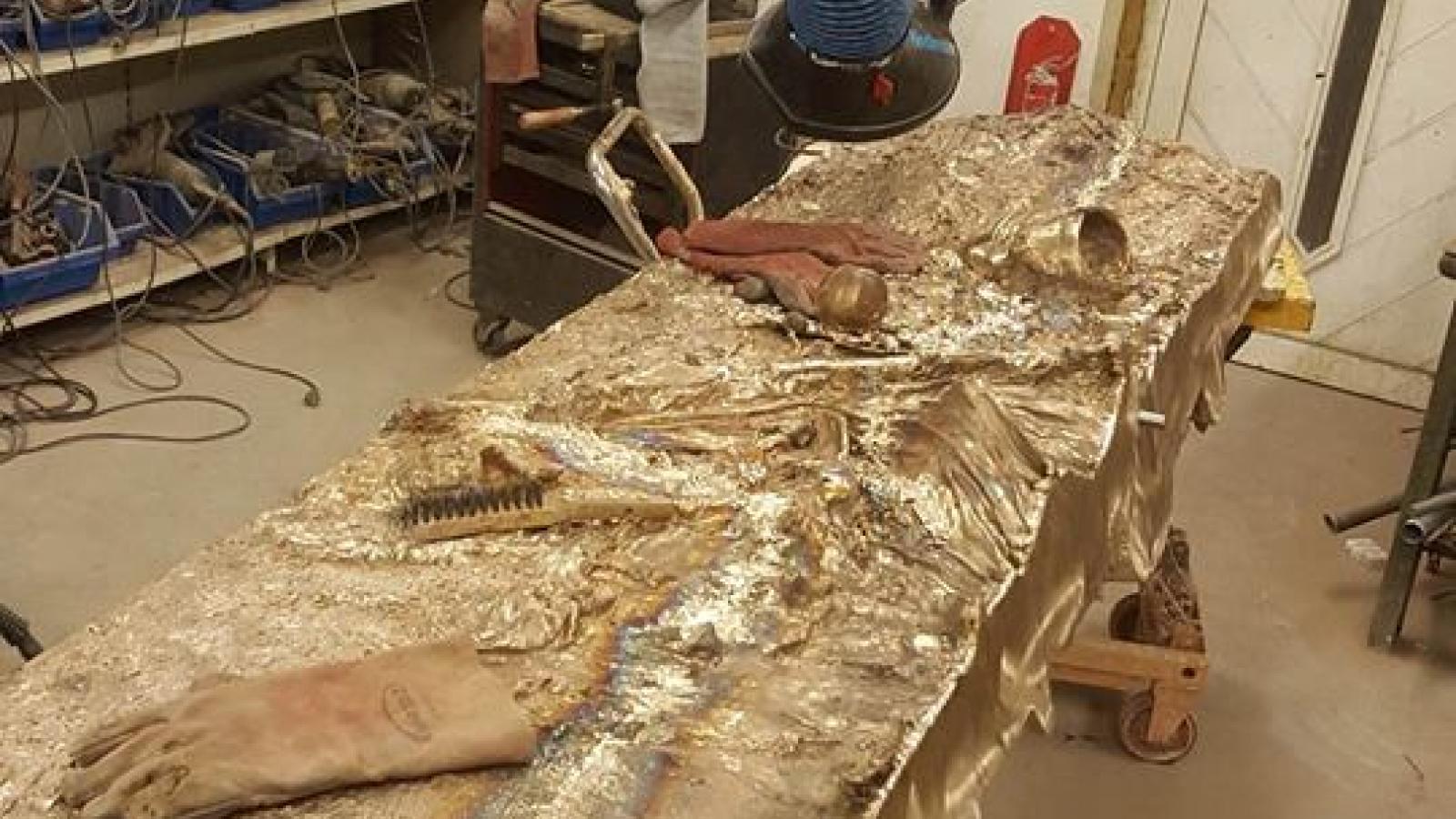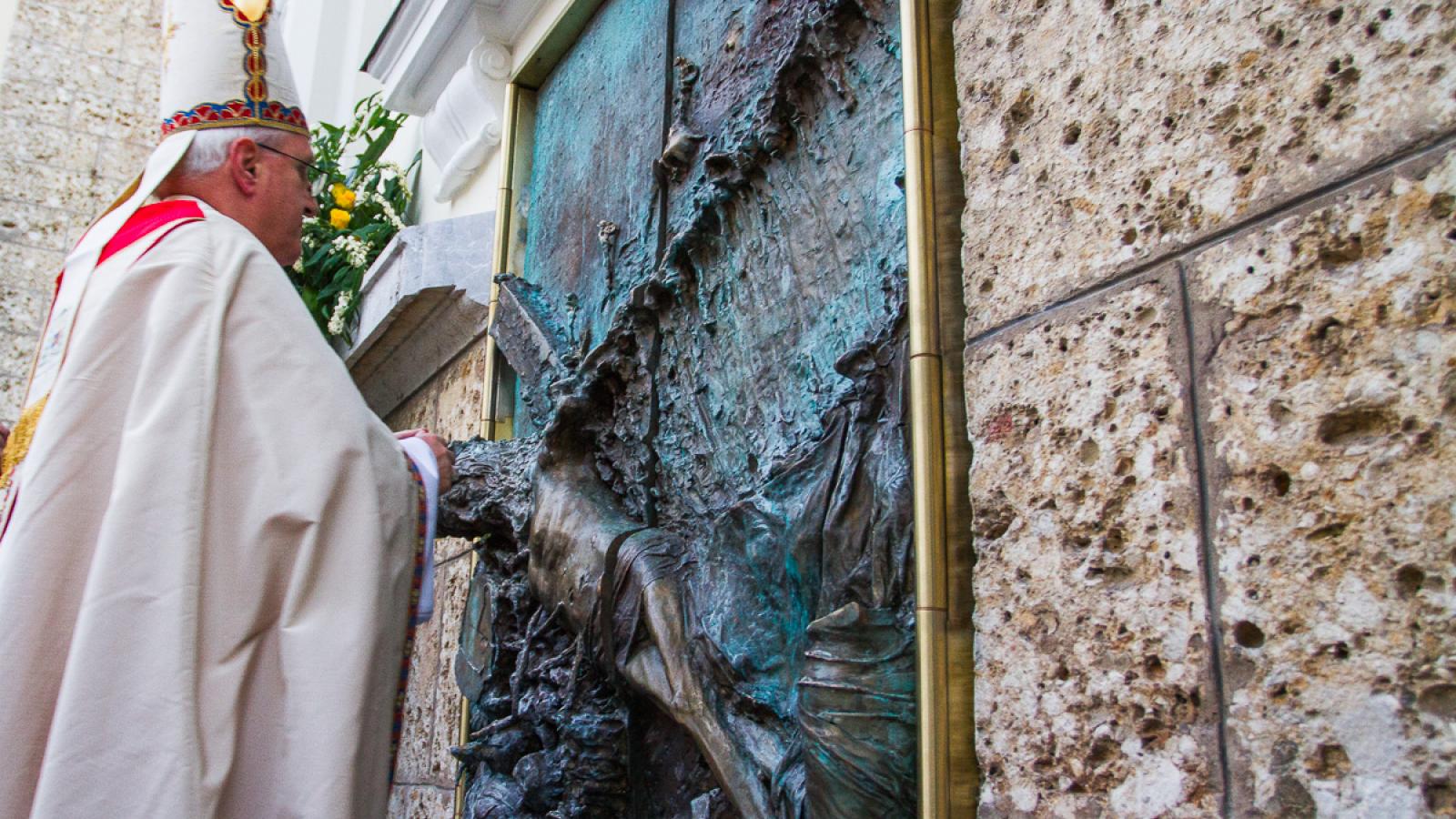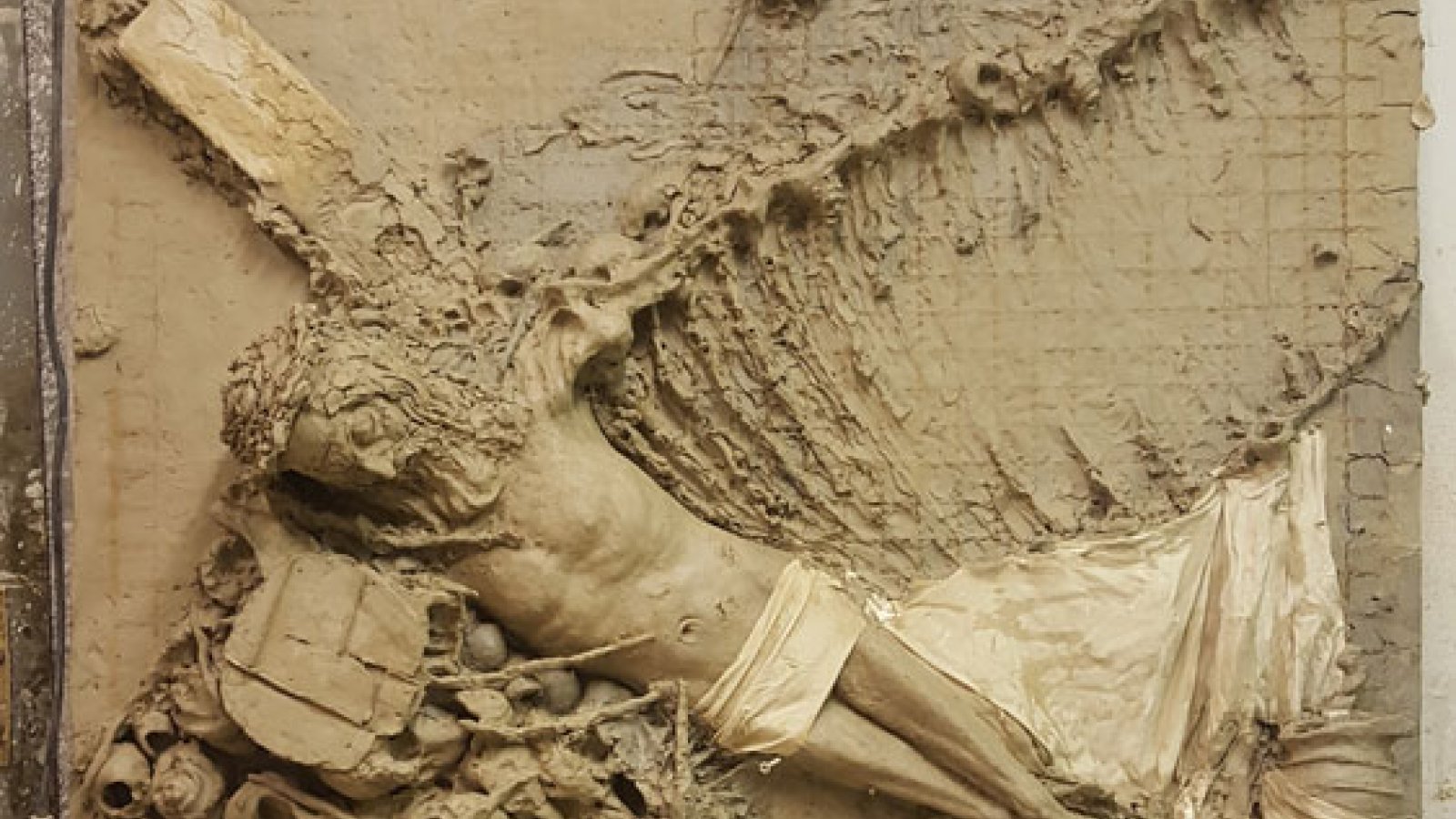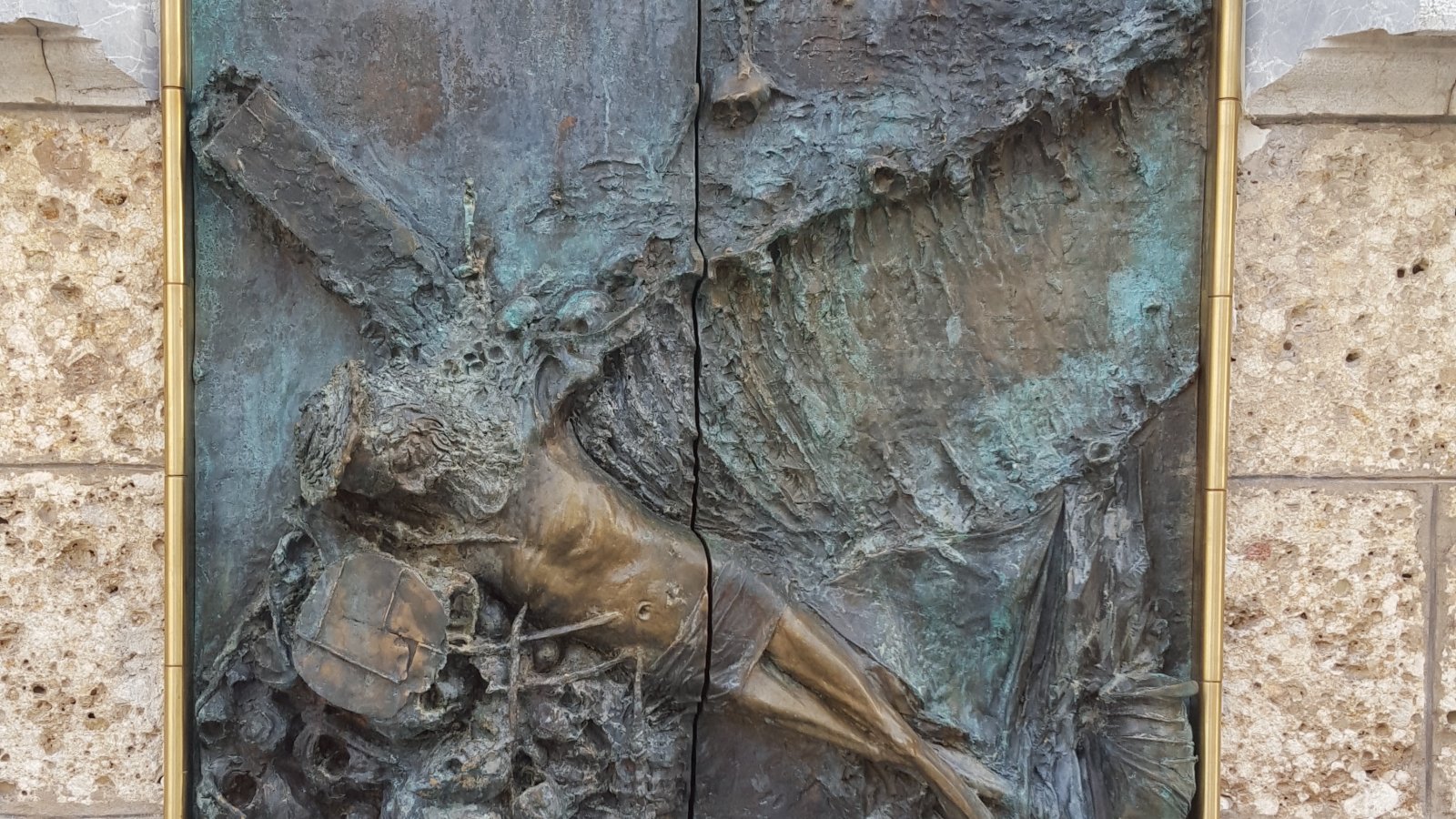The process of making bronze holy door - Brezje
The story of the creation of a bronze door with a bronze relief surface on both sides.
We use Silicon Bronze (CuSi3Mn1), which is very resistant to environmental influences (one liter has almost 9 Kg), is well cast (at around 1200 degrees Celsius), perfectly welded, processed, bent, flattened and patinated. When patinating, bronze is forced to be protected with oxides, which are of different colors. We do this by dissolving various salts in distilled water and applying them to a hot or heated bronze surface. The color obtained at the end is waxed with special waxes that separate the surface from the effects of the environment.
To start the process of casting bronze lost wax or investment casting, as we call this work differently, we need a MODEL. The model can be made using multiple materials.
Clay is mostly used, but also wood, plaster, stone, paper, cloths, styrofoam, aerated concrete, polyurethane, etc ...
In this case, which I am describing, we prepared a steel base for the author, on which we stretched and welded a strong mesh, applied clay on it and leveled it. One base for the outside of the door and one base for the inside. The pads are of two dimensions taking into account any shrinkage of the materials during the process.
This is where the author’s work begins, which can take months, weeks or days. He models every millimeter along this surface, uses inserts of wood or fabric or something else to help him carry out the story. The author has already made a study or a plan of how he will form ideas in clay before the beginning of this material work.
When the author finishes his work, it is a MODEL for us.
From the model we have to make a MOLD in which it will be possible to make a wax secondary model, which is exactly like the sculptor's model, except that it has a certain thickness between 5 and 7 millimeters of wax.
So the whole door with all the figurines on the surface was WAXED in one part of the process.
The mold is made by applying silicone rubber in several layers to the author's model, which is for us when the exact negative surface record hardens. It hardens to a state of elasticity, it is like some thick skin of a model.
Apply PLASTER mother mold(CAP) reinforced with yarn and wood on the rubber. Remove the cap and turn it over, peel the rubber from the MODEL and place it in the CAP to get the correct position and shape. This is our MOLD and is a very accurate print or snapshot of what the author did. The mold is not one piece but is carefully divided into several smaller ones so that the process can be continued at all. In our case, there are nine pieces for the outside of both wings and nine for the inside of both wings.
MOLD is used to make a wax model. Apply hot wax to the mold with a brush, which cools on the surface and turns into a solid state. This can be done to the required thickness, wrapped or laid with hot soft wax panels, which determine the thickness of the wax model as well as BRONZE.
The greater the thickness of the wax, the greater the thickness of the BRONZE. The space left by the wax is later filled with BRONZE.
We stick wax tubes, ducts and vents on the wax models, retouch and eliminate any defects. The author in this part can add structure because WHAT IS WAX will later be BRONZE.
A waxed piece of door with channels and vents, which are also made by wax, is observed and poured (as if concreted) in an upright position with our foundry mortar (brick sand, plaster and water).
A hard block is formed in which a part of the wax door is watered. Filling channels and vents are also flooded.
We call this hard square a FORM. When we have done enough FORM, we fill the dryer and turn it on.
In a dryer called KOPA, the wax burns at 600 degrees Celsius and leaves the room in the form of a MODEL between 5 and 7 mm thick.
KOPA works for about 4-7 days, followed by 24-hour cooling.
The cooled FORMS are taken out and placed at the place of bronze casting. At this point, the door is nothing more than an air gap left by the wax in FORM. The molds should be surrounded by sand and hammered with it so that they do not open, explode or crush during the casting of the bronze.
At this time, the bronze is already melted, waiting at its casting temperature for casting.
Melt the bronze in kilns with a pot. The stove is cylindrical in shape and in the middle is a graphite pot around which fire circulates. A fire makes a huge oil or gas burner. In five hours, 300 kg of bronze is ready for casting.
From the kiln, which is a tilting bronze, we pour it into a walled container called FANA. FANA is on the elevator, so without much effort we also pour larger amounts of bronze into the FORMS. The casting of one FORM takes up to one minute, and the bronze also cools rapidly to such an extent that it is solid and withstands the opening or excavation of the mold.
Bronze pieces of the door are washed with water under high pressure and a mixture of quartz sand. This is followed by cutting the channels and pulling the nails, which served as a distance when there was no wax in the mold.
We weld the nail holes with the same material as the door and process them (CIZELING) so that it is not visible where they were. The parts of the door are welded together into a whole and the surface, especially the welds, are SCIZED again to such an extent that no traces of the process can be seen. Once the front and back of the door were fully welded and machined, the edges were straightened with a large hammer or mace, so that obtain two parallel surfaces. These two reliefs are combined into a whole at a distance of about 10 cm with the help of stainless steel profiles.
The cutting follows, so that we get two wings of the door, which, however, must fit into the opening in the basilica prepared by the master pasar. We took advantage of this moment to compare and we went to Brezje with a raw door and checked if everything was fine and that there would be no problems with installation.
This was followed by closing the edges with bronze plates, chiselling of all interventions and finally patination, which was done entirely by the author Mirsad Begić himself.
The installation was performed between the hours of twenty-two and twenty-three on New Year's Eve 2015. There were no errors or deviations due to the previous comparison.
Working New Year's Eve marked by the Holy Door and the Year of Mercy was a special experience that we will remember for a long time.




